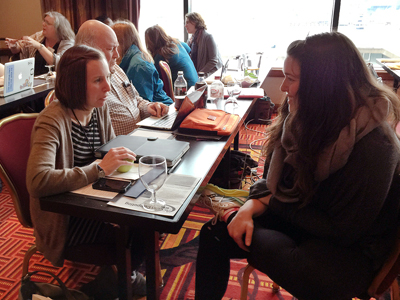Discussion Summaries (Increasing the Participation of Students with Disabilities in Exploring Computer Science and Computer Science Principles Courses 2015)

What aspects of the Exploring Computer Science (ECS) or Computer Science Principles (CSP) curriculum might present accessibility challenges?
- Programming environments and languages, including Python, Alice, and Scratch, may not be accessible to some students (e.g., those who are blind or who have mobility-related disabilities).
- Teachers without a strong computer science background are often resistant to learning another programming language or teaching multiple languages in one class.
- Some assignments, such as creating animations, are fundamentally inaccessible to some students with disabilities.
- Pair programming during the Advanced Placement (AP) test can create logistical problems between someone with a disability and someone who doesn’t.
- There is very little existing knowledge of how people with dyslexia, ADD, autism, or other invisible disabilities work in each programming language or utilize text-based versus drag-and-drop programming environments.
- Requesting accommodations for the AP test is cumbersome.
- Some teachers do not have the right resources—there may not be money in a school’s budget for accessible software or hardware.
- Teachers and students aren’t given the right tools or knowledge to surmount accessibility obstacles.
- There are very few computer science professionals with disabilities serving as role models.
What resources or tools would be helpful to prepare for students with disabilities in their courses?
- Create scaffolding (e.g., an outline of the program) to help students, especially those with learning disabilities.
- In pair programming or group activities, make sure there are multiple roles and ways to contribute, so students of all abilities can work together.
- Incorporate universal design when designing curricula and lessons.
- Work with special education teachers and other allies to determine what changes are needed in the classroom to make instruction more accessible in general or for a specific student.
- Discover what activities are both accessible and interesting, and look into alternatives, like a vocal interface for Scratch.
- Consider using unplugged activities (csunplugged.org), which can be very accessible and a great way to draw people in.
- Be aware that block languages can be great introductions to programming, but students who continue their computing education will move on to using text languages eventually.
- Look to professionals with visual or other disabilities to help students with disabilities learn to program.
- Identify inaccessible tools and ways to modify the tools to make them more accessible.
- Buy equipment and software that is more accessible, such as a talking debugger or a tool that beeps before all errors in a program.
- Contact the College Board to discuss accommodations and ask about the visual artifact requirement for the CSP assessment.
What resources or tools would be helpful to you or to teachers in order to be prepared for students with disabilities in their courses?
- Determine how to use a screen reader with text-based programming languages.
- Find out what environments are more accessible.
- Create materials for school administrators and counselors that show the potential for students with disabilities to take computer science classes.
- Demonstrate accommodations and how making a more accessible environment can allow students to work without modifications.
- Create resources so teachers know what tools/languages are the most accessible for people with different types of disabilities.
- Ensure that CSP students can create audio rather than visual artifacts to fulfill the visual artifact requirement of the AP exam.
- Provide a checklist for accessibility specifics in a number of activities, including unplugged activities and programming activities.
- Provide videos that model accessible lessons and accessibility issues in computer science.
- Create a website that compiles resources for high school teachers who work with students with disabilities, particularly a website that has resources for various types of disabilities.
- Provide grants for teachers to buy accessible or assistive technology.
- Provide workshops on accessibility through the Computer Science Teacher’s Association.